The decision to vacate Coral Gables City Hall again—this time to make way for what may finally be a comprehensive renovation—marks the culmination of years of delay. For more than a decade, engineering reports have warned of serious structural concerns, yet the city largely postponed decisive action. What’s unfolding now is not just a capital project but a civic reckoning: How does a city that prides itself on architectural heritage reconcile its historic image with the reality of deferred maintenance and growing safety risks? And when does preservation become performance rather than practice?
Engineering red flags spanning over a decade
Structural concerns at City Hall have been documented for years. Engineering reports prepared in 2011, 2023 and 2025 document a consistent pattern: Deteriorating concrete, corroding steel reinforcement and weakened structural elements. Spalled columns, exposed rebar, and cracking slabs have persisted despite surface-level repairs. The building—revered as a Mediterranean Revival landmark designed by Phineas Paist and listed on the National Register of Historic Places—now carries the dual identity of historic gem and structural liability.
The warnings have grown more urgent—and harder to ignore. A 2023 analysis by Ardaman & Associates found that one concrete sample contained chloride levels eight times higher than the threshold at which rebar begins to corrode. The 2025 report, prepared by structural engineers Wood/O’Donnell & Naccarato, identified four areas requiring immediate attention—including a north-facing column that appears to lack an internal concrete core. The column, believed to be made of stacked keystone segments, has since been shored up but is considered a structural risk. Engineers recommended sealing off four zones and removing overhead hazards to protect personnel. That these hazards persisted across three reports over 14 years suggests not just structural decay, but institutional inertia.
The recertification question
City Hall’s structural issues have raised another question: Should it have been recertified sooner? Under Miami-Dade County regulations, most buildings require structural and electrical recertification at 40 years of age, with follow-up inspections every 10 years. Given that City Hall was completed in 1928—making it nearly 100 years old—it would have met that threshold decades ago. In fact, Coral Gables commissioned a report in 2011, apparently to fulfill the 40-year recertification requirement. But what has happened since?
The law stipulates that inspections must be completed and reports submitted within 90 days of notification. Reports must identify any unsafe conditions, including unpermitted work or structural deficiencies, and while full compliance with current codes is not required, unsafe elements must be addressed. City Hall is not exempt: it far exceeds the size and occupancy thresholds.
As buildings age—especially coastal structures like City Hall—the timelines and requirements grow more stringent. Structures built before 1983 near the coast, such as City Hall, should have been recertified multiple times. It remains unclear whether the City of Coral Gables has consistently followed the 10-year inspection schedule—raising questions about whether image took priority over accountability. If not, that could reflect a broader problem: a disjunction between regulatory enforcement and political will.
Preservation vs. public safety
Preserving the past while protecting the present is rarely straightforward, and the debate over the building’s original windows illustrates that complexity. At a June 12 Historic Preservation Board meeting, City Manager Peter Iglesias proposed replacing the original wood-framed windows with hurricane-rated steel models. Iglesias, who recently returned to his post, argued that the old windows leak and fail to meet modern code. But board members countered that the windows are integral to the building’s historical integrity—and likely repairable. Former preservation officer Dona Spain urged Iglesias to reconsider the $3 million plan, saying: “Figure it out.” The board formally recommended restoring the original windows and hiring an architectural consultant to explore compliant alternatives.
The window dispute mirrors the broader challenge. The city estimates the full renovation will cost between $25 million and $30 million. But cost is only one part of the calculus. As engineers recommend modern reinforcements, and preservationists insist on authenticity, Coral Gables must decide what kind of restoration reflects its values: one that conserves detail, or one that prioritizes resilience. In Coral Gables, where form often doubles as function and aesthetic stands in for policy, every material choice—from the lintels to the window frames—carries symbolic weight.
Complicated exit
Complicating matters further is the city’s relocation strategy. Initially, all key departments were to move to the Public Safety Building on Minorca Avenue. But that plan changed. Now, only the City Commission will occupy the Minorca facility; other departments will scatter to leased offices along Ponce de Leon Boulevard.
This dispersal adds logistical strain—and political context. When City Hall was vacated in November 2023 over safety concerns, then-Mayor Vince Lago denounced the move as “political theater.” His foils, including Commissioner Ariel Fernandez, insisted it was a necessary precaution. After Commissioner Richard Lara’s win in April gave Lago back a majority, the commission returned to City Hall. That history adds a political undertone to the city’s second exit—this time framed as an engineering imperative.
Evidence mounts but questions remain
What distinguishes this moment is not the emergence of new evidence—the city already had two engineering reports by 2023 detailing structural hazards—but a belated willingness to act. Structural risks are no longer treated as theoretical or deferred to future study; they are documented, urgent, and now finally acknowledged. The decision to begin relocating personnel for what could be a year or more signals an institutional shift: the building’s deterioration can no longer be managed by patchwork fixes or political equivocation.
Still, the project timeline remains unsettled. So do the city’s intentions: Is it preserving a landmark, modernizing a facility—or attempting both? Is this a retrofit, a restoration or a reimagining? Preservationists advocate minimal intervention. City leaders must weigh budget, political capital and regulatory compliance. Residents, meanwhile, are left watching a fixture of civic life undergo uncertain transformation.
What’s at stake
The decisions Coral Gables makes now will echo beyond this renovation. A thoughtful, adaptive restoration—one that respects historic form while modernizing structural integrity—could become a model for how the city stewards its architectural legacy. A faster, more utilitarian approach might resolve immediate risks but at the cost of continuity and identity.
More broadly, City Hall’s fate may set precedent. Coral Gables has long prided itself on design standards and historic protections. But sustaining that image requires more than codified aesthetics. It demands long-term investment, interdisciplinary coordination and political will.
Whether City Hall’s renovation becomes a blueprint or a cautionary tale remains to be seen. But one message is already clear: the city must confront the gap between what it preserves in principle and what it maintains in practice. How Coral Gables navigates that divide—between memory and maintenance, symbolism and structure— may define the next era of civic life and reveal whether the city’s preservation ethos is grounded in principle or merely posture.






This Post Has 5 Comments
Thank you.
There is another defect at City Hall.
The lack of honesty, integrity, and transparency of Mr Lago and Mr Iglesias.
One cannot take anything they say at face value — because they not only hid the City Hall structural defects from the public for years, they hid the Zoning Code Re-Write, ad infinitum.
As for safety vs historic preservation, I choose safety.
Sincerely,
Jackson Rip Holmes
As a professional architect and amateur architectural historian, I have never understood the reverence for CG City Hall. It is a misproportioned mishmash of misused classical motifs overlaying a cramped, poorly designed, barely functional building. It looks like what it is: a showy pastry built by a land developer to help sell building lots. Tear it down; or our leaders lack the political will to do that, turn it into a museum of the history of real estate development.
Such blasphemy! Such heresy! You sir, thou should be shunned and banished from “The City Beautiful”! But thank you for your comment. 😊
https://youtu.be/2595abcvh2M
Hilarious! I agree. City Hall seems to be nothing special, especially in a community of beautiful old-Spanish homes, many of which were designed by the same architect. Even our “gates” at the corners of Coral Gables are better looking. Perhaps we could create something that mirrors the beauty of the neighborhoods, rather than preserve a misfit just because it’s been sitting there a long time.
The debate about the wood vs steel windows was addressed last night at the Coral Gables Museum by the renowned Spanish architect, Eduardo Martinez Moya during the Q&A after his magnificent presentation of the meticulous restoration of La Giralda bell tower in Sevilla, Spain. (The tower on the Biltmore Hotel is modeled after La Giralda.) Mr. Martinez Moya is regarded as one of Europe’s foremost architectural preservationists. A member of the audience asked his opinion about our City Hall’s window replacement options (and the questioner was quite frank about being in favor of the steel windows…although she mistakenly called them aluminum.) The expert preservationist left no doubt as to his opinion. Wood! When he was further pressed on the issue of water and our weather, his unwavering response was that wood was the material of choice, and today with the correct type of treated wood, all of those concerns could be mitigated. Talk about a timely presentation, followed by an unequivocal answer, by the most experienced expert in the field. And free advice, to boot!